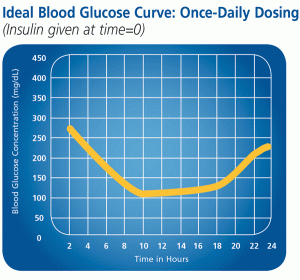 A Pomeranian with Diabetes: Chip’s Diagnosis
A Pomeranian with Diabetes: Chip’s Diagnosis
I had no idea what the future held on February 16, 2011. My 7-year-old Pomeranian, Chip, was diagnosed with diabetes. I was shocked. I didn’t know dogs could be diabetic. Chip had always weighed more than he should have, and that contributed to his diabetes. No matter how hard I tried, I couldn’t get his weight down. It seemed the harder I tried, the more he gained. Chip was 18 pounds and diabetic… now what?
Early Signs of Diabetes in Pomeranians
The previous year during his yearly medical exam and blood work, we discovered Chip had thyroid issues. It was a simple fix with prescription soloxine and monitoring through blood work. While monitoring his blood work, the vet discovered Chip had diabetes. I started to notice that the water in the bowl was disappearing faster than normal but didn’t think much of it. I also noticed accidents in the house but had difficulty figuring out who was responsible because I had another Pomeranian, D.D., a rescue Shepherd mix, Rhett, and a cat, Chloe. The diabetes diagnosis explained it — it was Chip. Excessive urination and drinking are classic signs of diabetes in Pomeranians.
Managing Diabetes in Pomeranians: A Scary Start
 It seemed simple enough to fix — consistent feeding and insulin shots twice daily, 12 hours apart. But I felt so intimidated, so afraid. What if I hurt Chip? What if I gave him too much insulin? I could do it, I had to do it — for Chip. The vet’s office had me practice my shots, and then sent me home… still basically an amateur shot-giver. Whew, it was scary.
It seemed simple enough to fix — consistent feeding and insulin shots twice daily, 12 hours apart. But I felt so intimidated, so afraid. What if I hurt Chip? What if I gave him too much insulin? I could do it, I had to do it — for Chip. The vet’s office had me practice my shots, and then sent me home… still basically an amateur shot-giver. Whew, it was scary.
My fear subsided when I got the hang of it, and it actually went pretty well. We had to run weekly blood curves, which is a blood sampling method administered like this:
- Just prior to insulin administration
- Then, in 60 to 120-minute intervals
- Over a period of 12 hours, ideally for 24 hours
Insulin Resistance
After several weeks, we found Chip’s magic insulin number and were sent home with instructions to call if the excessive urinating and drinking started again. A few months later, the bottom fell out. Chip’s body stopped responding to insulin. So, we switched to another insulin with negative results. Then we switched him to Levemir insulin, which is four times stronger than most insulins. We saw some response but not enough. Chip became sick. He stopped eating and lost half of his body weight. He dropped from 20 pounds to 10 pounds seemingly overnight. My little boy, who used to eat everything, refused to eat. Without food, insulin would make his sugar drop too low. Without insulin, his sugar would skyrocket.
Diabetes Complications in Pomeranians: Chip’s Decline
 In the middle of this battle, Chip lost the use of his right leg and then his left. The vet thought he had torn both ACLs, but surgery was too risky with his diabetes out of control. Now Chip couldn’t walk, wouldn’t eat, and just stayed in the same spot. I held him as much as I could. I didn’t know how long I had left to hold him.
In the middle of this battle, Chip lost the use of his right leg and then his left. The vet thought he had torn both ACLs, but surgery was too risky with his diabetes out of control. Now Chip couldn’t walk, wouldn’t eat, and just stayed in the same spot. I held him as much as I could. I didn’t know how long I had left to hold him.
We returned to the vet once or twice a week, but eventually, we were referred to a veterinary specialist hospital. Chip’s blood sugar was dangerously low at 60. For a diabetic Pomeranian, ideal numbers are between 100 and 200. If I hadn’t gone in that day, Chip might not have made it through the night. Small miracles.
A New Hope
With the guidance of Chip’s new vet, we found the right combination of food and insulin. We used prescription food and reduced his insulin dosage. Slowly, Chip started to heal. I was taught how to do physical therapy on his atrophied leg muscles. Twice a day, I used hot and cold compresses and performed range-of-motion exercises. Over several months, Chip learned to walk again.
A Champion Returns
 Chip came back to life! He could walk! He was eating, and his blood sugars were under control! We even participated in a fundraiser for the American Diabetes Association, where Chip was named a Champion to Stop Diabetes. This became an opportunity to spread awareness about canine diabetes. Through Facebook groups of diabetic dog owners, I learned more about managing Pomeranians with diabetes. I had no idea I should home test Chip’s blood sugar using a meter designed just for dogs. This home testing became a lifesaver.
Chip came back to life! He could walk! He was eating, and his blood sugars were under control! We even participated in a fundraiser for the American Diabetes Association, where Chip was named a Champion to Stop Diabetes. This became an opportunity to spread awareness about canine diabetes. Through Facebook groups of diabetic dog owners, I learned more about managing Pomeranians with diabetes. I had no idea I should home test Chip’s blood sugar using a meter designed just for dogs. This home testing became a lifesaver.
Today, Chip is doing well. He never regained full use of his right leg and has a limp, but he is thriving. We continue to face challenges with his diabetes and other conditions like Atypical Canine Cushing’s Disease, but we manage them. Chip remains our Champion, and we continue to raise awareness for Pomeranians with diabetes.
Related Posts:
Diabetes in Pomeranians: What You Need to Know
Health Issues Concerning Pomeranians
Can Pomeranians Eat Nuts? A Guide for Pommy Parents

 A Pomeranian with Diabetes: Chip’s Diagnosis
A Pomeranian with Diabetes: Chip’s Diagnosis